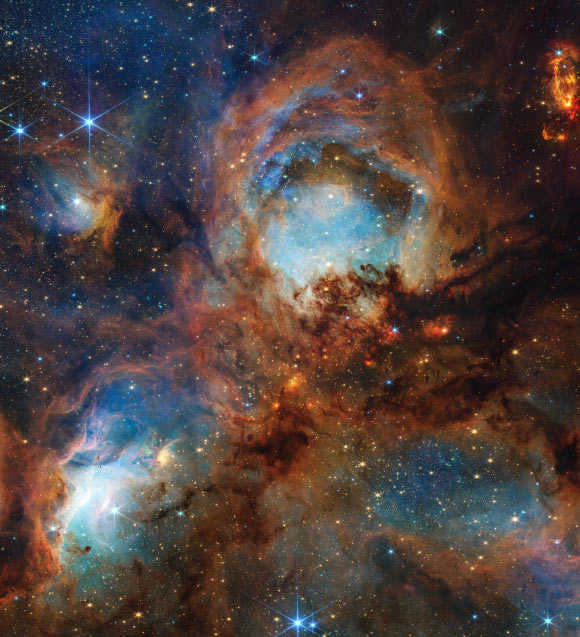To mark its third year of highly productive science, astronomers used the NASA/ESA/CSA James Webb Space Telescope to image a portion of the Cat’s Paw Nebula.
This Webb image shows the Cat’s Paw Nebula, a massive star-forming region located 5,500 light-years away in the constellation of Scorpius. Image credit: NASA / ESA / CSA / STScI.
The Cat’s Paw Nebula resides in the southern constellation of Scorpius and is approximately 5,500 light-years away from Earth.
Discovered by the English astronomer John Herschel in 1837, this star-forming region is estimated to be between 80 and 90 light-years across.
Also known as NGC 6334 and the Bear Claw Nebula, it is one of the most active stellar nurseries in the night sky, nurturing thousands of young, hot stars whose visible light is unable to reach us.
The new image from Webb’s NIRCam instrument shows never-before-seen structural details and features.
“Massive young stars are carving away at nearby gas and dust, while their bright starlight is producing a bright nebulous glow represented in blue,” Webb astronomers said in a statement.
“It’s a temporary scene where the disruptive young stars, with their relatively short lifespans and luminosity, have a brief but important role in the region’s larger story.”
“As a consequence of these massive stars’ lively behavior, the local star formation process will eventually come to a stop.”
“Start with the region at top center, which is nicknamed the ‘Opera House’ for its circular, tiered-like structure,” they said.
“The primary drivers for the area’s cloudy blue glow are most likely toward its bottom: either the light from the bright yellowish stars or from a nearby source still hidden behind the dense, dark brown dust.”
“Just below the orange-brown tiers of dust is a bright yellow star with diffraction spikes.”
“While this massive star has carved away at its immediate surroundings, it has been unable to push the gas and dust away to greater distances, creating a compact shell of surrounding material.”
“Look closely to notice small patches, like the tuning fork-shaped area to the Opera House’s immediate left, that contain fewer stars.”
“These seemingly vacant zones indicate the presence of dense foreground filaments of dust that are home to still-forming stars and block the light of stars in the background.”
Toward the image’s center are small, fiery red clumps scattered amongst the brown dust.
“These glowing red sources mark regions where massive star formation is underway, albeit in an obscured manner,” the researchers said.
“Some massive blue-white stars, like the one in the lower left region, seem to be more sharply resolved than others.”
“This is because any intervening material between the star and the telescope has been dissipated by stellar radiation.”
“Near the bottom of this region are small, dense filaments of dust.”
“These tiny clumps of dust have managed to remain despite the intense radiation, suggesting that they are dense enough to form protostars.”
“A small section of yellow at the right notes the location of a still-enshrouded massive star that has managed to shine through intervening material.”
“Across this entire scene are many small yellow stars with diffraction spikes.”
“Bright blue-white stars are in the foreground of this Webb image, but some may be a part of the more expansive Cat’s Paw Nebula area.”
“One eye-catching aspect of this Webb image is the bright, red-orange oval at top right.”
“Its low count of background stars implies it is a dense area just beginning its star-formation process.”
“A couple of visible and still-veiled stars are scattered throughout this region, which are contributing to the illumination of the material in the middle.”
“Some still-enveloped stars leave hints of their presence, like a bow shock at the bottom left, which indicates an energetic ejection of gas and dust from a bright source.”
